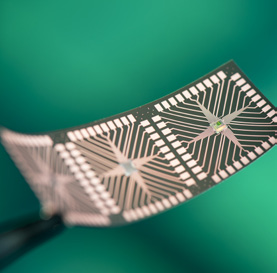Intelligent energy supply for smart objects
It is forecast that there will be up to 24 billion networked things around the world by 2020. Over a third of these will be “smart” everyday objects that will communicate and interact within the Internet of Things. One sticking point is the energy supply: smart objects need to be self-sufficient in order to be able to work for as long a period as possible. As part of the EU’s EnSO project, 39 partners from eight countries are working on new solutions for an intelligent energy supply.
The aim of EnSO (“Energy for Smart Objects”) is to develop AMES, or autonomous micro-energy sources. AMES combine various elements such as energy harvesting, energy management, and micro-energy storage in order, ideally, to allow them to operate for a lifetime. As part of the project, researchers at the Fraunhofer Research Institution for Microsystems and Solid State Technologies EMFT and the Fraunhofer Institute for Integrated Circuits IIS are developing concepts and technologies to manufacture, integrate, and embed electronic microchips in autonomous energy supply units.
Thin, flat, and flexible
The construction height of the compact packages is intended to be considerably less than 1 mm. Furthermore, the packages are intended to be mechanically deformable in order to allow them to fit into differentshaped environments. To this end, the experts plan to embed a very thin and flexible microchip into an ultra-flat foil housing. Different technology concepts are going to be tested for the contacts: in addition to flipchip approaches where the chip is placed face down on a wiring foil and is contacted and embedded, new technologies will also be used where the chip is placed face up on a foil and embedded using, say, a casting compound. The electrical contacts and the wiring level with the outward connections will then be added using conventional thin-film lithography processes. While the first demonstrator of an ultra-thin film package in EnSO will be based on flip-chip technology, the next generation will make use of film packages with microchips in a face-up configuration.
New chips for energy harvesting
The project is also producing various microchips for the realization of self-powered energy harvesting systems. A high-efficiency voltage converter with an extremely low start-up voltage allows thermoelectric generators to be used with even the smallest temperature differences. Another energy management ASIC combines charging and monitoring circuits for micro-batteries and super capacitors as well as a wide range of energy management functions that allow operation of conventional wireless sensor systems with energy sources from the environment. In order to significantly increase the bandwidth and thus the area of application of energy harvesting systems of this nature, the research team is also developing electronic circuits to adjust the resonance frequency of vibration harvesting systems. The project is being funded by the ECSEL initiative within Horizon 2020, the EU framework program for research and innovation, and the German Federal Ministry of Education and Research (BMBF).
Last modified:

